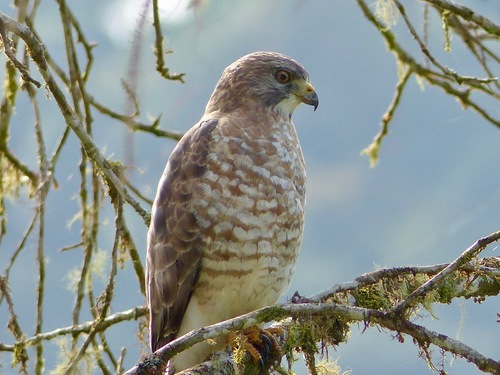
Broad-winged Hawk
The Broad-winged Hawk (Buteo platypterus) is a small, compact raptor renowned for its impressive long-distance migrations. These hawks are a common sight in the forests of eastern North America during the breeding season, playing a crucial role in controlling populations of rodents, insects, and amphibians. Unlike some larger hawk species, they are relatively inconspicuous in their woodland habitats until migration time, when they gather in enormous flocks, called 'kettles,' that can number in the thousands. This spectacular migratory behavior has made them a subject of great interest to birdwatchers and researchers alike.
34-44 cm
Length
81-100 cm
Wingspan
Least Concern
Conservation Status
Distribution
Breeds primarily in eastern North America, from southern Canada to the Gulf Coast, and west to the Great Plains. Some breeding also occurs in western North America. Winters in Central and South America, as far south as Bolivia and southern Brazil. Migrates through Central America and along the Gulf Coast.
Lifespan
Up to 12 years in the wild, although many do not survive their first year.
Broad-winged Hawk's Habitat
Habitat Types
Deciduous forests, Mixed forests, Forest edges
Climate Zones
Temperate, Subtropical, Tropical
Adaptations
Broad wings are well-suited for soaring on thermals, allowing for energy-efficient long-distance flight during migration. Their relatively small size allows them to maneuver within dense forest canopies.
Variations
Several subspecies are recognized, differing slightly in size and coloration. For example, *B. p. cubanensis* is a smaller, darker subspecies found in Cuba.
Appearance
Breeding Plumage
Adults have dark brown upperparts and pale underparts with horizontal brown barring. The tail has broad black and white bands. Immature birds have more streaking on the underparts and less distinct tail bands.
Seasonal Feather Changes
Plumage is generally consistent throughout the year, with some wear and fading possible before molting.
Sex Based Plumage Differences
Plumage is similar between sexes, although females may have slightly heavier barring.
Notable Features
Relatively short, broad wings, Broadly banded tail, Dark 'malar' stripe (on the face)
Diet and Feeding
Primary Foods
Small mammals (voles, mice, chipmunks), Amphibians (frogs, toads), Reptiles (snakes, lizards), Insects (caterpillars, beetles), Birds (nestlings)
Foraging Behavior
Typically hunts from a perch within the forest, scanning the ground for prey. May also hunt by soaring low over the canopy. During migration, they may feed on insects caught in the air.
Specializations
Sharp talons and a hooked beak are adapted for capturing and consuming prey.
Seasonal Diet Variations
Diet varies depending on prey availability. During the breeding season, they may take more amphibians and reptiles, while insects may be more important during migration.
Behavior
Social Structure
Generally solitary or in pairs during the breeding season. Highly gregarious during migration, forming large flocks (kettles).
Communication
A high-pitched, whistling 'kee-eeee' call, Visual displays during courtship and territorial defense
Migration
One of the most impressive long-distance migrants among North American raptors. They travel thousands of kilometers between their breeding and wintering grounds, often in large flocks that follow specific routes, taking advantage of thermals and updrafts.
Territorial or Group Behaviors
Territorial during the breeding season, defending their nesting area from other hawks. They are not territorial during migration.
Conservation
Threats
Habitat loss (deforestation in both breeding and wintering grounds), Collisions with vehicles and structures, Pesticide exposure (indirectly through prey)
Protection Programs
Monitoring of migratory populations (e.g., Hawk Mountain Sanctuary), Habitat conservation efforts, CITES Appendix II (regulates international trade)
Local National Laws
Protected under the Migratory Bird Treaty Act in the United States.
Population Trend
Stable
Population Estimates
Global population estimated at around 1.8 million individuals.
Interesting Facts
They form massive flocks during migration.
These 'kettles' can contain thousands of birds, creating a spectacular natural phenomenon.
They are one of the smallest *Buteo* hawks in North America.
Their small size allows them to be agile within forests.
They rely heavily on thermals during migration.
Thermals are rising columns of warm air that allow them to soar with minimal effort, conserving energy during their long journey.
Faqs about Broad-winged Hawk
Where can I see Broad-winged Hawks?
During the breeding season, look for them in forested areas of eastern North America. During migration, they can be seen at hawk watch sites along migration routes, particularly in the fall.
What do Broad-winged Hawks eat?
They eat a variety of small animals, including rodents, amphibians, reptiles, insects, and occasionally birds.
Are Broad-winged Hawks endangered?
No, they are currently listed as a species of Least Concern by the IUCN.
Copyright @ Nature Style Limited. All Rights Reserved.
 English
English